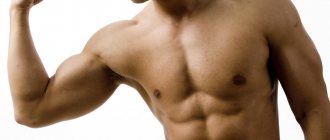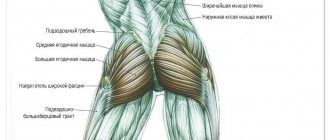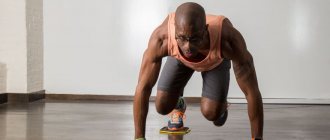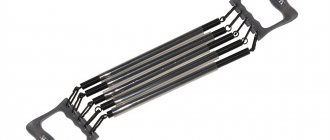Hello! Let's take a look at the best chest exercises that can take your chest workout to a whole new level. Naturally, I will give specific practical schemes for different levels of fitness and note many interesting features in training the pectoral muscles.
Articles with exercises for the pectoral muscles:
- Dumbbell bench press on an incline bench;
- Incline barbell press;
- Guillotine press;
- Dips;
- Bench press exercise on an incline bench
- Chest training program No. 1 (for beginners)
About the anatomy and growth rules for the pectoral muscles
I will not dwell on these points in detail, because... I looked at all this in great detail in an article on how to pump up your breasts at home.
The most important thing that you must pay attention to and be sure to remember is that the pectoral muscles consist of:
- pectoralis major muscle (m. pectoralis major);
- pectoralis minor muscle (m. pectoralis minor);
- serratus anterior muscle (m. serratus anterior);
Another very important point is that the pectoral (pectoral) muscles are unique to some extent because they are attached at different angles to the sternum and collarbones, forming the letter “L”, which is why they need to be trained at different angles.
As you can see, everything is not quite complicated. We must train different parts of the pectoral muscles from different angles.
Now a little about the rules for growth not only of the pectoral muscles, but of all muscle groups, in principle.
For high-quality powerful growth of any muscle group, you need to follow only three basic rules:
- Progressive load (creating conditions favorable to the body for growth).
- High-quality recovery (fractional meals 6-12 times a day + 8-10 hours of sleep).
- Muscular feeling (the load must hit the target exactly, you can find out more in this article).
I already talked about this in an article about training the pectoral muscles at home, I gave the link above, read it.
The load should increase (weight on the bar, number of approaches, repetitions, exercises, super techniques, etc.).
You should recover well (eat frequent small meals 6-12 times a day and sleep well for 8-10 hours).
You should feel the muscles you are training and turn off all other muscles.
That, in fact, is all that can be said about this.
Bend push-up

The point of this exercise is to keep your legs higher than your head. You need to put your feet on some kind of elevation and do regular push-ups. This exercise will involve the upper chest, as well as the main muscle groups of the arms. When performing this exercise, you should pay attention to the correct placement of your elbows. If possible, try to move them apart to provide maximum load to the chest muscles.
The main mistakes when training the pectoral muscles
Many people make the same mistakes when training their chests. These errors severely hamper possible progress.
Too much weight on the apparatus
In any gym you can see a similar mistake when, even if not always a beginner, uses too much weight on the barbell or dumbbells.
He writhes, grimaces, helps himself with his legs, back, all parts of the body, just to squeeze the weight, believing that the more he presses, the better the progress of the pectoral muscles.
This is wrong. The load is thus simply “spread” over other muscles, leaving the chest. Naturally, breasts do not grow.
The body always strives to save energy, so it will tend to violate the technique of performing exercises.
Your task is to monitor the progression of the load, but in such a way that you maintain the correct technique.
We will talk about it further.
Using only a horizontal bench in exercises
Many people overestimate the importance of the flat bench press for pectoral muscle growth.
As we said, the pectoral muscles (pectorals) are attached to the collarbones and sternum at different angles, accordingly, they need to be trained at different angles of the bench.
The bench press on a horizontal bench affects primarily the lower chest area, which itself grows much easier than the upper chest, but is much smaller in size.
Accordingly, for the development of the pectoral muscles, this is not the most preferable bench press option.
Only by experimenting with the sensations of the pectoral muscles at different angles of the bench can one achieve their comprehensive development.
By the way, I don't do flat bench presses at all, I only do incline bench presses (20-30 degrees), and my pecs often look better than those of many people who focus on flat bench presses.
Few basic exercises and many isolation exercises
Some beginners focus on isolation exercises, believing that in this way they will expand the chest and work on their form. this is mistake!
It is possible, but not in the form in which they do it. More on this a little later, but in general, the classic version: first basic exercises (presses), and then isolating exercises (dumbbell flyes, crossover exercises, pullovers, etc.).
It is the basic exercises that will allow you to take more weight on the apparatus and progress the load more easily.
Then there are isolation exercises that can tire your muscles even more deeply, and fill them with blood.
There is an option when you can do isolation exercises instead of basic ones, namely when training slow muscle fibers! This is the so-called static dynamics!
In order to ensure that the pressure in your body does not create problems during MMV training, you need to focus on isolating exercises and give preference to “seated” exercises instead of “standing” ones.
However, we talked about this in this article. And we’ll talk in more detail in other articles.
Too much rest between sets and exercises
This point is very important. If you want beautiful, aesthetic breasts, then you should not rest for more than 1-1.5 minutes. Maximum 2 minutes!
With each approach, fatigue should become stronger and stronger.
A good indicator that you are doing everything right will be a decrease in the number of repetitions in each approach!
If you perform a set to failure every time, then you most likely will not be able to perform the same number of repetitions in the next set. It will be something like this:
- 80 kg x 10;
- 80 kg x 9;
- 80 kg x 8;
- 80 kg x 7;
- 80 kg x 6;
Too many exercises in chest training
Thus your efforts are dissipated. I always believe that it is better to do 3-4 of the most effective exercises for one muscle group, but increase the number of approaches to 5-6, or even 7, than to perform 7-8 exercises, doing 2-3 approaches each.
When people run from one machine to another, first with a barbell bench press, then with a dumbbell press, then with parallel bars, then with a hammer, then with flyes, then with a crossover, etc., then, most likely, as strange as it may sound, they are not giving enough load.
I'm not talking about professional athletes who can train for 2 hours or more. I am targeting the average person who wants to develop impressive sized breasts.
And in professional training you can often find only 4-5 exercises per muscle group.
Pectoral muscle training for mass
If you have recently started bodybuilding (less than a year), then it is best to use basic exercises, since thanks to them you will progress faster and gain muscle mass in your chest. And when your pecs are more or less developed, then you can add isolated exercises (no more than two).
What grip should you use when training your pectoral muscles?
For safety, it is best to use a “closed” grip, where the thumb wraps around the bar (under the letter B in the picture). This way you will insure yourself against the fact that the barbell may simply slip out of your hands (your palms will sweat and the barbell will “move”). In addition, do not grab the bar with too wide a grip, as this will create additional stress on the shoulder joints, which is not good. The best option is a grip slightly wider than shoulder width. When you lie down under the bar, make sure the bar is at eye level. This is the correct position.
Correct technique
If you are doing pressing movements, make sure that your elbows do not diverge to the sides and are not pressed to the body. The correct position of the elbows is approximately 45 degrees relative to the body. At the bottom, your forearms should be perpendicular to the floor.
If you do flyes, make sure that your arms are slightly bent at the elbow joint throughout the exercise.
Do not lift your lower back off the bench and rest your feet on the floor.
Insurance
In all pressing exercises, it is better to use the help of a partner or ask someone from the gym to back you up. This way you can better concentrate on the exercise and not think that if you can’t squeeze the barbell again now, it will crush you.
Also, be sure to put locks on the barbell so that if the barbell becomes skewed, all the weights won’t fall off.
Correct "bodybuilding" technique
These tips are specifically for a bodybuilder, not a powerlifter. The main goal of bodybuilding is to increase muscle volume while maintaining an aesthetic physique.
Not overcoming maximum weight, but increasing muscle volume while maintaining ideal proportions! Do you feel the difference?
In order for muscles to grow, the load must increase, we talked about this at the very beginning of the article. But the load should increase not only bluntly due to the increase in weight on the apparatus, but also due to “switching off” the remaining muscles from work and complicating the work on the target group, i.e. breast.
Naturally, this way your weight on the bar will decrease, but the load will hit the target.
To complicate the work of our chest, the following conditions must be met:
- Partial range of motion is an excellent solution for bodybuilding because... allows you to keep your muscles in constant tension (no rest). Due to the reduction in amplitude, the weight on the bar will practically not fall. You can work at your previous working weight.
- The trajectory of the barbell movement – the barbell must move in an arc! Start at the bottom of the chest, and end at the top of the chest.
- Leg Position – A bodybuilder’s legs should be higher than a powerlifter’s. You can put them on a stand or move the bench to the row of dumbbells and put them there. This way, you remove the “bridge” (you don’t arch your back), thereby isolating the pectoral muscles even more. Plus, in this position, you do not help yourself with your legs, without involving other muscles in the work.
- Pectoral contraction at rest - you must learn to contract the pectoral muscles at rest, i.e. as if to “twitch” them. Focus on reducing them, so it will be easier for you to feel them while working in the gym.
- Grip width and position of the forearms - the grip width should be such that at the lowest point of the range of motion of the barbell, the forearms become parallel to each other. If you are working in partial amplitude, then the grip should be slightly wider than usual.
- Do not squeeze your shoulder blades together - this helps you squeeze out more weight, but takes the load off your chest. You will press more weight, but your chest will receive less load.
- The inclination of the bench - approximately 20-30 degrees upward from the horizontal - allows you to distribute the load more evenly across the entire chest.
- The number of approaches and repetitions is the classic repetition regime for a bodybuilder: 6-12. This applies to training fast muscle fibers. For slow ones, the range is slightly different (they focus on the failure time of 30-50 seconds). As a rule, approaches should not be done less than 4. After all, the chest is a large muscle group.
- An open grip is a grip where the thumb does not close the hands into a ring around the bar. This helps to better focus on contracting the pecs, but this grip is dangerous for beginners, so it is only suitable for more advanced athletes.
Dips with emphasis on the pectoral muscles
First of all, make sure that when doing dips, you focus on your pectoral muscles. To do this, move your legs back, lean forward as much as possible and do not bring your elbows to your sides as you lower your torso.
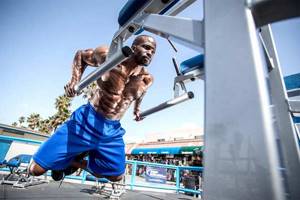
Dips with emphasis on the pectoral muscles
Tip: If you are a strong and experienced athlete, then dips will be a great way to end your workout. If not, do them first. To achieve a pump, superset dips with classic push-ups at the end of your training session.
Chest exercises
Exercises for the chest, whether for girls or men, should be divided into two large groups:
- Presses (barbells, dumbbells, Smith).
- Breedings (dumbbells, crossovers, hummers, etc.).
Presses are basic exercises (work 2 joints: shoulder + elbow), and fly-ups are isolating exercises (work 1 joint: shoulder). This is why we will start our workout with presses and end with flyes for deeper fatigue.
Presses (depending on the projectile):
- Barbell;
- Dumbbells;
- Rama (in Smith);
Presses (depending on the angle of the bench):
- Upside down;
- Horizontal;
- Upside down;
Presses (depending on grip width):
- Wide;
- Average;
- Narrow;
As you can see, there are a lot of options.
The higher the angle of your body, the more the upper chest works and the less the lower chest. But the tilt should not be more than 40-45 degrees, because... The higher the head tilt, the more the deltoids and triceps are involved in the work.
Therefore, I advise you to tilt your torso at about 20-30 degrees. This way the load will fall more evenly than without an angle of inclination.
If the inclination of the torso, on the contrary, is below the horizontal, then the lower chest works more, but the triceps are more involved in the work. Deltas at a negative angle of inclination are turned off.
The narrower the grip, the greater the amplitude of movement and the more difficult it is to press. But the narrower the grip becomes, the more the triceps are involved in the work.
Accordingly, if you highlight a certain ideal formula, then from the point of view of efficiency you need to reap:
With a medium grip, on a bench with a positive inclination of 20-30 degrees from the horizontal.
Now let's select the best chest exercises in terms of effectiveness.
Is it possible to pump up your chest with push-ups?
The shape of the pectoral muscles is determined by genetics, and training cannot change it. But you can increase the volume of muscle fibers. The only question is what load causes the greatest hypertrophy (growth). What does chest training for weight include and how to pump up your chest with push-ups at home? Let’s not let any intrigue arise and let us immediately inform you that you can’t pump up chest like Arnold’s with push-ups. But you shouldn’t give up the exercise. Suffice it to remember that push-ups are a basic exercise used in training boxers and soldiers.
. So how to do push-ups to pump up your chest and how much do you need to do to see visible results?
The Most Powerful Chest Exercises
These chest exercises should be in every bodybuilder's arsenal.
I really like working out my chest muscles, because... These muscles are quite easy to feel and not so difficult to pump up if you understand some of the conditions that we will talk about below.
Due to the fact that the pectoral (pectoral) muscles are attached with the letter “L” to the sternum and collarbones, as we talked about above, we need to train them from different angles. The variety of exercises plays a major role here.
Bench press exercise on an incline bench
Perhaps the #1 exercise for building huge pectoral muscles.
As I said, the optimal slope would be about 20-30 degrees. It is not necessary to go higher, because Deltas will definitely come into play.
Very often, sports equipment manufacturers make a fixed bench angle of 45 degrees. This is very shitty, because... necessarily includes deltas in the work.
Therefore, I would advise taking a regular incline bench with the ability to change the angle of inclination and placing squat racks on the sides of it, putting a bar there and voila. The bench press we need is ready.
About the grip width. We take the barbell with a medium grip, because... this gives us a greater amplitude of movement, and accordingly complicates the work, and does not allow the triceps to engage in work.
We try to work within the amplitude (do not touch the chest with the bar and do not straighten the elbows completely at the top point), this will prevent the chest from switching off.
Next important point, put your feet up! You can bring yourself a footrest, for example. This will prevent you from arching over the bridge so that the load does not go into your legs, back, etc. you need to press without a bridge (straight back). You lose the opportunity to “cheat”.
Now about breathing.
There's nothing unusual here. Exhale as you push, inhale as you lower the barbell down.
As for the elbows, they need to be spread apart! This way you will focus on the pecs and not the triceps (when your elbows are parallel to your body, the triceps work).
I also recommend doing 6-12 reps. I generally work in the range of 6-10 repetitions. Although, if you are just starting out, then you can do even more repetitions, about 15-20. Select the weight so that muscle failure occurs in this rep range.
You don’t need to do any other barbell presses for now!
Let's structure a little information received about this type of bench press.
Technique:
- Lie down on the bench, remove the bridge, press your back tightly to the bench! You can also raise your legs up to isolate your pectoral muscles. This way you can lift less weight, but the load will go directly into the pectoral muscles, and will not be spread across the front deltoid, triceps and back.
- Take the bar of the bar slightly wider than your shoulders (at the lowest point your forearms should be parallel).
- After this, we lower the barbell down without touching the pectoral muscles at the lowest point! Feel your pecs stretch. At the same time, we draw air into our lungs.
- Now with a powerful movement, focusing on working the pectoral muscles, press the barbell up.
Important: do not straighten your elbows completely, so as not to remove the load from the pectoral muscles and not to direct it to the elbow joints.
- Now squeeze your pecs using a peak contraction.
Important: Imagine that your hands are up to your elbows from your shoulders, this is just a connecting link, and your hands end at your elbows. Push with your elbows, not your hands! This way you will focus the load on the pectoral muscles, removing it from the front deltoid and triceps.
Exercise dumbbell bench press on an incline bench
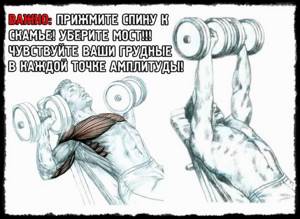
Incline Dumbbell Press – This is the next super effective exercise. We will be working on an incline bench!
The dumbbell press is much more difficult to perform than the barbell press, so, for example, if you bench press a 100 kg barbell for one rep, then you will not be able to bench press two dumbbells weighing 50 kg each.
When pressing dumbbells on a bench, there is no bar between the dumbbells, i.e. there is no additional stabilization that simplifies the work, so the body is forced to connect many stabilizer muscles, which are smaller in size and weaker in the generated force.
This is necessary in order to stabilize the movement of each hand individually.
Everything about the angle of the bench, the position of the elbows, etc. remains the same.
There will be two main differences:
- Dumbbell level at the lowest point.
- Method of lifting dumbbells to the starting position.
About the level of dumbbells at the lowest point. They will be slightly lower than with the barbell press, because... There is no “limiter” in the form of a neck in the middle. Therefore, we lower our arms down all the way, until the pectoral muscles are fully stretched.
The method of lifting dumbbells must be learned so as not to get very unpleasant injuries.
Just one disclaimer first: if you can't lift the dumbbells to the starting position on your own, then the weight is too heavy for you!
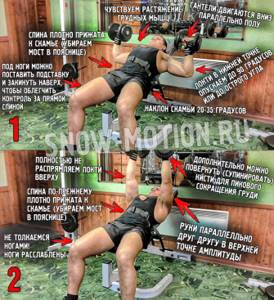
Technique:
- We take dumbbells in two hands and straighten the body (dumbbells on the sides).
- We rest the dumbbells just above the knees (on the front surface of the thigh), and smoothly sit down on the bench.
- With a powerful movement, we lean back, simultaneously pushing the dumbbells with our knees so that they are in the area of the shoulder girdle (dumbbells below).
- Remove the bridge, press your back tightly to the bench! You can also raise your legs up to isolate your pectoral muscles. This way you can lift less weight, but the load will go directly into the pectoral muscles, and will not be spread across the front deltoid, triceps and back.
- We spread our elbows to the sides (dumbbells parallel to the body), inhale lungs full of oxygen.
- After this, we press the dumbbells upward with a powerful movement, while exhaling air.
- Now squeeze your pecs using a peak contraction.
- Slowly lower the dumbbells down, feeling how the pectoral muscles contract at each point of the movement! At the same time, we draw air into our lungs.
Exercise guillotine press
A great exercise for developing chest muscles!
This is a variation of the bench press, except that the bar of the bar is lowered towards the throat.
But why lower the bar specifically to the throat? Does this look like some kind of inconvenient nonsense?
Yes, everyone thought so, until one scientist in the world of “smart bodybuilding” - Bret Contreras analyzed the electrical activity of most of our muscles during a variety of exercises using electromyography (EMG).
It turned out that if you shift the load vector from the chest a little higher to the throat, then almost the entire array of pectoral muscles begins to be involved in the work.
This was amazing and shocked most scientists and athletes at that moment!
- Starting position: Grab the barbell with a grip slightly wider than shoulder-width.
- Grip: You can use an open grip if you are an experienced athlete. For beginners, I advise using a closed grip.
- Remove the bridge, press your back tightly to the bench! You can additionally throw your legs up (as in the picture below) to isolate the pectoral muscles. This way you will be able to lift less weight, but the load will go directly into the pectoral muscles, and will not be spread over the legs, anterior deltoid, triceps and back.
- We begin to lower the barbell strictly vertically above our neck, and while lowering we take a deep breath.
- We lower the bar to a distance of 3-5 cm to our neck, feel the tension and stretching in our pecs, you can additionally linger in this position for 1 second.
- After this, with a powerful movement we squeeze the barbell up above our neck, while exhaling air. Important: do not straighten your elbows completely, so as not to remove the load from the pectoral muscles and not to direct it to the elbow joints.
- Now squeeze your pecs at the top using a peak contraction.
- Again, slowly lower the barbell down to the neck, feeling how the pectoral muscles contract at each point of the movement! At the same time, we draw air into our lungs.
- We perform the number of repetitions specified in our program.
Important: Imagine that your hands are up to your elbows from your shoulders, this is just a connecting link, and your hands end at your elbows. Push with your elbows, not your hands! This way you will focus the load on the pectoral muscles, removing it from the front deltoid and triceps.
Here's a visual of how it's done:

Also, to make it easier to remove the bridge in the back, to focus on the pectoral muscles, you can throw your legs on the bench:
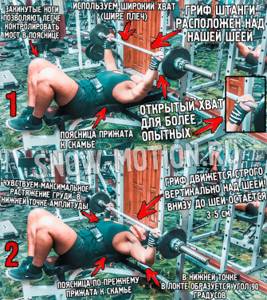
Now, let’s move on to isolation exercises for the chest.
Dumbbell flyes lying on a bench
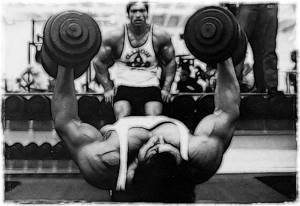
This exercise is isolating, i.e. It uses only one joint, which means you can work with much less weight than in presses or push-ups. It should be performed after basic basic exercises (presses and push-ups).
Very often people do not understand the fundamental difference between basic and isolation exercises. They say that basic exercises are “for mass”, and isolation exercises are “for form”. But this is not true!
You still work on a muscle for mass or for shape, it does not have a brain, it either contracts or lengthens due to some kind of load. And which one, it doesn’t matter to her either. That's not the point here.
An isolation exercise does not allow you to fully load the muscle and use significant weight, because Only one joint works, where there are a lot of weak links (ligaments, cartilage), so the progression of the load in such exercises is very problematic.
That's the whole secret. Basic exercises, due to the work of several joints, enable the body to distribute the load more evenly and make work more comfortable when working with heavy weights.
Technique:
- We take dumbbells in two hands and straighten the body (dumbbells on the sides).
- We rest the dumbbells just above the knees (on the front surface of the thigh), and smoothly sit down on the bench.
- With a powerful movement, we lean back, simultaneously pushing the dumbbells with our knees so that they are in the area of the shoulder girdle (dumbbells below).
- Remove the bridge, press your back tightly to the bench! You can also raise your legs up to isolate your pectoral muscles. This way you can lift less weight, but the load will go directly into the pectoral muscles, and will not be spread across the front deltoid, triceps and back.
- We hold dumbbells parallel to each other along our body. Then we squeeze them up.
- We spread our arms to the sides to the point of maximum chest stretch. Stretch your chest well.
- Then with a powerful movement, maintaining tension in the pectoral muscles, we bring our arms back to their original position.
Important: Think about your elbows as you would for bench presses. Imagine that you are hugging a large tree.
Tip: When your arms are almost brought together, slightly rotate your hands with the dumbbells inward (supination) towards your chest, this way you will further shorten them.
Raising and closing hands in a crossover

I love working in crossover. It makes it possible to do the exercise in a mode in which it is impossible to do it with dumbbells.
These are also isolation exercises.
As I said, our muscle fibers in the pectoral muscles are located under the letter “L”, which is why they need to be trained at different angles. In a crossover, you can achieve this rule perfectly by simply changing the height of the rollers on the struts.
I would even recommend, if possible, to perform fly-ups not with dumbbells, but in a crossover, because... this allows you to never stop working the pectoral muscles.
The weight on the crossover cables always pulls! Therefore, it is difficult for you to both raise your hands up and lower them down. This is difficult to achieve with dumbbells, because, as a rule, at the top point the arms with dumbbells relax.
You maintain tension at every point in the amplitude.
The angles can be very different:
- above;
- below;
- horizontal;
- intermediate;
Now I will not consider this breeding option in great detail, because the crossover has a lot of useful features and it deserves a separate article.
I suggest that you first try doing crossover flyes while lying on an incline bench.
The technique will be the same as when doing dumbbell flyes on an incline bench, you will just feel a constant tension in the pectoral muscles. The only difference is that you don’t have to throw the dumbbells up, but just take the handles in both hands.
It’s better to tell you more about the technique for bringing hands together in a standing crossover.
Technique:
- Take the handles in your hands. Stand exactly in the middle of the machine.
- Now walk forward a little with your arms outstretched until you feel a stretch in your pectoral muscles.
- You can keep your legs together, or slightly apart, but on the same line! There is no need to step forward with one foot, because... this creates torsional stress on the spine due to torque.
- Bring your arms together in front of you with a powerful movement. Using a peak contraction, additionally squeeze your pecs at the point of maximum tension.
- Now spread your arms back until the tension in your pectoral muscles remains. Stop at the point where the tension still remains and bring your hands together in front of you again.
Work at home: how to pump up your pectoral muscles?
A special set of exercises will correct the shape of the muscles and keep them in good condition. But the main thing is to keep up with your goal and always achieve more in training than was previously planned. If you quit work in the middle or because the result is not yet visible, then even a professional trainer will not be able to help you.
You should start with push-ups, since this complex does not take much time, it is not difficult, but after seven to ten days the result will be visible and you will be able to pump up the pectoral muscles. Although it is important to follow a cyclical schedule and repeat the exercises at least four times a week. If you use weights or loads, the result will appear faster and will be more outstanding. As for the opinion of experts, they do not consider this complex to be the best, but if we talk about the time spent and the results, then it is fully justified.
At the same time, select the method of push-ups that is most convenient for you: spreading your arms to the side - the entire load is transferred to the middle of the chest; if your arms are along the body, then the upper part, shoulder and triceps swing. As an option, you can try push-ups with clapping, as well as jumping, because then the load on the muscles will be even greater, while exercises on the uneven bars help work the lower chest.
As for the results, you shouldn’t expect anything special, since only a full complex and the use of exercise machines and parallel bars will bring positive results for the pectoral muscles in combination with a good trainer who will give you a slap on the head if anything happens)
How to build a training regime?
One of the most important factors in training is the training regimen, because beginners often, without knowing the system, train every day, applying the maximum load. But they still don’t see quick and real results. Because every activity threatens microtrauma to the muscles, so they need rest and recovery. If they do not have time to recover, then subsequent loads will not bring any benefit, and therefore there will be no result. To pump up your pectoral muscles, follow the rules and routine.
As experts note, the average rest time is five days, but it all depends on the muscle group and type of training. If necessary, time is added up to a week. Sometimes the problem may lie in nutrition, since protein deficiency is often one of the main reasons for long recovery times.
Breast exercises: tightening and enlarging the pectoral muscles for women
Everything is clear with chest muscles for men, but what about chest exercises for women?
It's not that simple.
The fact is that women have smaller pectoral muscles by nature. Now I'm talking specifically about the muscles, and not about the entire chest.
In women, the breasts consist of:
- Pectoral muscles.
- Mammary glands.
- Fat.
This is what a woman's breasts look like under the skin:

Basically, this is pure iron, and the pectoral muscles are very small and are located under the iron and fat.
That is why for women there is no need to train the chest separately; it is enough to include 1-2 exercises in your general set of exercises.
So what are the best exercises to add to your program?
I would recommend two exercises:
- Dumbbell bench press on an incline bench.
- Guillotine press.
Because In girls, the nutrient accumulation system works a little differently, and the consumption and accumulation of glycogen occurs more efficiently, then I would advise performing these exercises for 3-5 approaches and 12-15 repetitions in each.
I am sure that for the vast majority of girls these two exercises will be more than enough to pump up beautiful, sexy breasts and make them more toned after just a few weeks of regular training.
Dumbbell floor press
Having regular dumbbells will allow you to significantly diversify your training program. The most universal exercise is the following: take the starting position lying on your back, bend your legs at the knees, and stretch your arms with dumbbells up. Then, as you inhale, slowly lower your arms until your elbows touch the floor. Try not to rush, perform this exercise at a smooth, even pace. A regular folding athletic bench, which you can buy at any sports store, can significantly diversify such exercises with dumbbells.
Remember that nothing is impossible. With a certain amount of desire, even at home you can achieve excellent results. Find for yourself an additional incentive for regular exercise, allocate free time, and the results you will receive will pleasantly please you.
Chest exercises: effective training programs
By tradition, I will give several sets of exercises for developing excellent breasts for athletes of different fitness levels.
Chest training program No. 1 (for beginners)
- Incline bench press: 2 warm-up + 3-4 x 6-12 reps;
- Dumbbell bench press on an inclined bench: 1 size. + 3-4 x 6-12 repetitions;
To get started, this will be enough for you. There is no need to do isolation exercises yet. Learn to feel your pectoral muscles. Learn to shorten them wisely. This is the key to success in pumping up any muscle group.
Chest training program No. 2 (for beginners)
When the load becomes insufficient for you (after 2-4 weeks), you can move on to the second complex. Let's add one more exercise and an additional working approach.
- Dumbbell bench press on an inclined bench: 1 size. + 4-5 x 6-12 repetitions;
- Guillotine press: 2 warm-up + 4-5 x 6-12 reps;
- Lying dumbbell fly: 1 size. + 4 x 10-15 repetitions;
Chest training program No. 3 (advanced)
So, your fitness has increased (after 1.5-3 months). It is necessary to increase the amount of work performed again. The next set of exercises is just for you.
- Dumbbell bench press on an inclined bench: 1 size. + 5 x 6-12 repetitions;
- Guillotine press: 2 warm-up + 5 x 6-12 reps;
- Raises of arms in a crossover lying on an inclined bench: 1 size. + 4-5 x 10-15 repetitions;
- Crossover while standing: 1 size. + 4-5 x 10-15 repetitions;
This is already a very serious load. You will already notice how your pectoral muscles have become fuller, larger and juicier.
Further, I think there is no point in listing possible sets of exercises, because for 99% of beginners this will be enough. There are a huge number of alternatives.
Next, for example, you can add training of the slow muscle fibers of your chest to the end of your workout. Fantasize, friends, look for the optimal solution specifically for yourself and listen to your body! It will never deceive you.
Exercises for training
The simplest and most universal exercise available to anyone starting to develop their body is simple push-ups. If we take a closer look at the mechanism of the push-up process, we will see that this is a kind of variation of the bench press. In addition, push-ups are an optimal general developmental exercise. When doing push-ups, the muscles of the arms are also involved, which ensures uniform development of the muscles of the upper body. In addition, there is an active effect on the abdominal muscles, which has a beneficial effect on the entire body as a whole. The leg muscles are used to a lesser extent, but they also receive a small share of the load.
Like many physical exercises, push-ups have different variations, using which you will load different groups of pectoral muscles.




